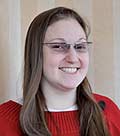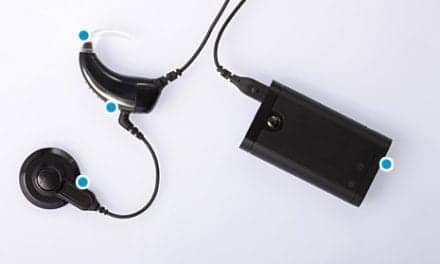Six tips for students (and others) visiting an exhibit hall
With so little time and so much to see, students and other attendees are often at a loss about what to see during a convention. Here are some tips for exploring the exhibit hall.
With hundreds of activities and only a few short days, it is difficult for the seasoned professional to plan for the American Academy of Audiology’s AudiologyNow! Convention. Decision-making is no easier for students—particularly those who may be attending the convention for the first time. Between lectures, poster presentations, lunches, volunteering, job searching, networking, parties, and the exhibit hall, it seems as if there will never be enough time to fit it all in! With so much to learn and so little time to do it in, many students are torn among a myriad of activities and inadvertently miss out on others.
Until recently, controversy swirled over the 150-plus exhibitors, as many handed out free gifts to attendees who visit their booths and learn about their products. However, beyond the controversy lies the real reason that the companies, which provide us with products from hearing aids to cerumen removal aids, are present at the exhibit hall: to promote and spread awareness about their products. However you might feel about this controversy, it’s impossible not to see the value in devoting a good portion of your time in the exhibit hall.
The exhibit hall may be the only place where students are exposed to all of the products available for their patients. To help give students an edge when visiting the exhibit hall, this article presents six suggestions on how to fit the exhibit hall into a busy schedule and to maximize this exceptional educational experience.
The following reflects some of my own journeys while visiting the AAA exhibits, and is meant only as an example to get students to build a strategy for exploring the hearing industry. While I mention several companies by name, due to space constraints, many excellent companies are necessarily omitted. To find a more complete list of the exhibitors, see the AudiologyNOW! Program Guide and the special HR Walking Guide to the 2010 AAA Convention found in this edition of The Hearing Review. Use them to map out your own course at the upcoming convention in San Diego.
Tip #1: Hearing Aid Companies
No matter how many clinical placements you may have as a student, it is unlikely that you will get a chance to become familiar with all of the hearing aid companies and their products. Take time at the exhibit hall to broaden your hearing aid knowledge base. Some examples? You might take an hour or two to focus on the “Big-6” hearing aid manufacturers and their offerings. Stop by Siemens and ReSound and listen to their newest hearing aids while getting a tour of the latest software. Check out Oticon, Phonak, and Widex to learn about their devices, as well as their wireless and FM systems, and find out how the latter are not just an option for the pediatric population. See what’s happening in the student area at Starkey, but do not forget to learn about their new software and product releases, as well as the Starkey Hearing Foundation “So The World May Hear.” Also get updated on the offerings of other important hearing aid manufacturers like Sonic Innovations, Rexton, Audina, Bernafon, Unitron, Sebotek, and others. There are always new entrants in the field with new technologies and form factors; make sure you familiarize yourself with these products.
Get to know your reps! Many of the hearing aid companies offer within their booths a place to sit, as well as food and drinks. Do not sit by yourself! Instead, ask to be introduced to your regional representative and, if possible, have them join you for a cup of coffee. Your rep is a great resource who can provide you with information regarding the products, as well as local seminars. They may even be able to help you find a job in the future. Reps are your direct contact at the company and are the ones who can help you navigate when you need more information on products. They are also people you may need for a future favor or extra help; an introduction and a short conversation with them can prove very beneficial.
Do not forget to ask the exhibitors about the latest research that is being done with their products. Universities are not the only places where research takes place! Just as you would with any research, do not take the information presented at face value. Ask the researchers questions about their data and remember that product improvement requires feedback from the consumers—so feel free to provide your own input.
Tip #2: Earmold Companies
As a student, I had the most difficult time understanding the differences between the various earmold materials (which differ from one company to another), much less how to choose the best ones for my patients. This was explained very easily, though, when I stopped by the Westone and Microsonic booths at the convention. Not only did they have several samples of each material, but one of the employees took the time to walk me through how each different type would fit my patients best. I was given samples of each of the materials, as well as the colors. When I got back to my supervisor the next week, I felt much more confident in my ability to choose the best earmold material and style.
There is a wide range of impression and earmold companies to visit, including Insta-Mold, Mid-States Laboratories, Perfect Seal, and Precision Laboratories. In addition to the above, several companies specialize in hearing conservation products, earplugs, and swimplugs, including Doc’s Proplugs, E-A-R/Aearo (3M), Etymotic Research, and McKeon—many of which you may have had little exposure to prior to visiting a convention hall.
Tip #3: Testing Equipment
In all likelihood, you’ve used only a relatively small number of hearing testing, screening, balance, and hearing aid testing devices. A convention exhibit hall is a perfect place to gain more familiarity on the wide variety of products and brands available in this category. Each company has a slightly different approach to gathering and displaying useful, quality, replicable data for your own unique clinical requirements. Look around to see who best fits your practice’s needs (and future needs). As with hearing aid and earmold companies, speaking to the representatives and technology developers can greatly enhance your understanding of the devices—as well as the particular testing method, in general.
Examples on your list might include companies like Audioscan, Etymotic, Interacoustics, Maico Diagnostics, MicroAudiometrics, Neurocom, Otodynamics, and Otometrics. You might also want to familiarize yourself with some of the sound booth providers like Eckel, ETS Lindgren, Industrial Acoustics, and Acoustic Systems.
Tip #4: Textbooks and Patient Material
As much fun as it is purchasing the books chosen by professors at the beginning of each semester (I hope you note my ironic tone), it can also be fun to pick out the ones that you want for your own collection. Delmar Learning, Plural Publishing Inc, and Thieme are just three of the many publishing companies that sell books at the convention. They bring copies of each book, and you can flip through them—something you cannot do online. Many of the companies offer discounts if you purchase at the convention. You can also purchase books that have not yet been released and have them delivered directly to your home.
Your patients need high-quality information as well. Some offerings include the publications offered by Auricle Ink, Hearing HealthCare News, and the professional organizations like AAA, ADA, and ASHA. Similarly, today’s patients may be particularly interested in financing and warranty services. That means you may wish to visit companies like CareCredit, ESCO, Discovery Hearing Aid Warranties, Midwest Hearing Industries, and others.
Tip #5: Accessories and ALDs
Sure, hearing aids and test boxes are great, but just like with the latest mp3 device, it is all about the accessories! Check out Harris Communications to try out some of their new phones for hearing-impaired individuals. See the newest style of hearing aid retention at Ear Gear. Have kids with hearing loss who like jewelry? See the fabulous styles of Tube Riders for hearing aids and cochlear implants. Try TV Ears and find out for yourself how they sound. Learn about the patient products for cerumen removal from Miracell and Debrox or find products for yourself at Hal-Hen. Stop by the Rayovac, Energizer, and other battery-maker booths to learn about batteries and how seasoned audiologists use battery clubs in their practice.
When entering into the world of patient care, you will be asked about the products listed here, as well as many more of which you may not be aware. Take advantage of visiting different companies at the exhibit hall that provide some of the lesser-known accessories. Your patients will appreciate your wide range of knowledge.
Tip #6: Explore and Broaden Your Horizons with Random Stops
Have you ever heard of Perfect Seal Laboratories, Neuromonics, Hermetic Switch, or Insta-Mold? Speaking for myself, none of these companies was mentioned to me at school or at any of my clinical placements. On one of my trips to the exhibit hall, I decided to make a list of companies that I’d never heard about and seek them out; I discovered that several play important roles in the industry and offer very interesting products.
Since then, I have realized that for students (and probably experienced professionals as well) there are a lot of “unknown” companies that have a lot to offer me and my patients. Feel free to walk into the booth of a company with which you are not familiar. Most exhibitors are happy to tell you about their services and/or products and will happily answer your questions.
The opportunities at the AAA AudiologyNow! convention are wonderful, and it is up to the audiologists and the students to make the most of them. It is important to remember that the exhibit hall really has nothing to do with gifts and incentives (from both sides of the aisle); conventions are about broadening your knowledge base so you can provide the best possible services and products to your patients. The fact is that this is what everybody wants.
Plan ahead and include in your list of activities a day to tour the exhibits. Do not forget to bring a comfortable pair of shoes to make walking a more comfortable experience. The knowledge you gain is extremely useful in the clinic—and it is information you might never receive in a classroom or seminar.
Citation for this article:
Jacques BA. Getting the most out of your convention experience. Hearing Review. 2010;17(3):32-35.






